-
Posts
189 -
Joined
-
Last visited
Content Type
Profiles
Forums
Store
Help Articles
Posts posted by Pizza Napoletana
-
-
Another 2 Neapolitan Easter recipes, from last year,
Agnello al Forno (in Naples we use Goat Kid, but in London I had to use Lamb, roasted with new potatoes and shallots)
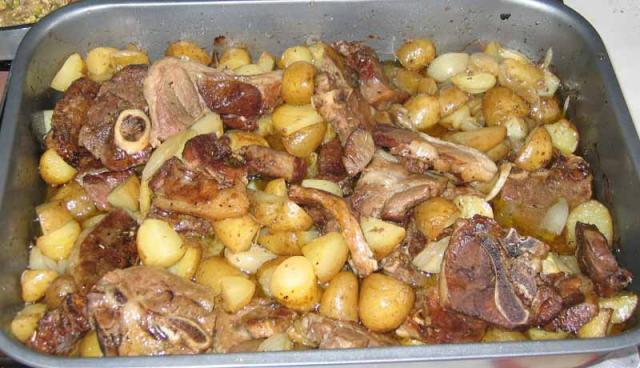
and Agnello Cacio and Uova (it should have been again Capretto -goat kid, with eggs, parmesan, pecorino and garden peas)

-
And this year baking:

-
Sorry if I get to this post so late, but I have just noticed a quote about casatiello and would like to make some clarity. Casatiello is on thing and Tortanto is another (or at least are different).
Basically, Casatiello is a lard enriched dough, with grated pecorino and parmiggiano as well as black pepper. Once molded into a ring, whole eggs (with all the shell) are added on top and fix with some dough.
A tortano is based on the same enriched dough (including b pepper and grated cheeses) but it is flatten, cubes of provolone, caciocavallo, salami and cicoli are added, and then rolled and form into a ring. You can also add eggs as for the casatiello, but it is not a must.
I will later attache this year pictures, however for now find below last year pictures, also including Pagnotte con l'olio (olive oil, gaeta olives, fennel seeds, chayenne pepper rolls) and 2 Pastiera (ricotta and wheat neapolitan ester cake)
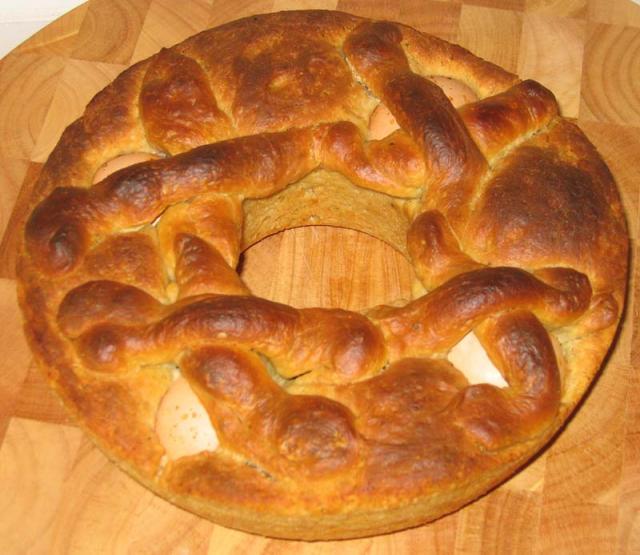
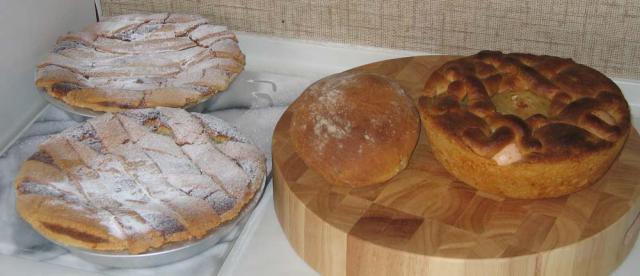
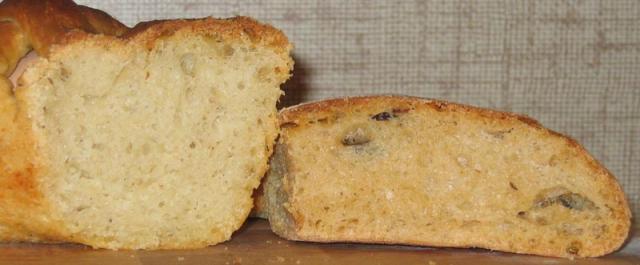
-
are you referring to Antonio Latini's 1692 Lo Scalco alla moderna?
on a side note, I have read what I believe to be the earliest recipes titled as "Pizza" (in Scappi, c. 1570) but they are nothing like what we know as pizza today, and I would be very interested to know when you find the transition to something like the modern Pizza Napolitana.
Yes, I was referring to Latini book (of which I own a copy in Italian) but as I said in the Ragu thread, abotanist talked about the strange custom for neapolitan to eat tomatoes much earlier.....
On the side note, I have many reference to pizza in Campania bibliography since about 1000's.
However it is important to note that I believe the TRUE PIZZA NAPOLETANA is about a special "crust" and simple topping and do not necessaryly need tomato. Pizza Napoletana is about a special soft dough, baked in the hottest possible neapolitan pizza oven Forno Napoletano for about 45-60 seconds (90 tops). Well there are several reference that make this pizza exist since about 1660 and I would say that if people wrote about it then, the same exact product was made at least 100 years before (and I mean different from Focaccias and Schiacciatas).
-
We have talked about this book in the Ragu thread some time ago. It was found in the Archive of Catel Nuovo (Maschio Angioino) Castle in Naples not to long ago. It basically change all it has been written before about Neapolitan cusine and the fact that Corrado was the first to write a recipe including tomatoes (we now know that it was actually almost 100 years later). It has been a key bibliography for my research on pizza napoletana.
Ciao
-
I may add that there is actually a cookbook from 1600's that was recently re-published in Naples that report a recipe for tomatoes....
-
Good news for anyone interested. After a long time of closure due to re-location and refurbishment, the best pizzeria in Naples (and province) is due to re-open after Easter.
SALVO PIZZAIOLI DA 3 GENERAZIONI
Largo Arso 10/16 San Giorgio a Cremano (NA).
I'll post the opening date as soon as I get it.
Ciao
-
My family onw a land planted with olive trees near Gaeta above the town of Formia. We have been producing our own Brine olives and olive oil for the last 20 years...
Gaeta olive cannot be missing in my fridge, and always come back from Italy with a bout 1kg of those.
-
I also applied this year without having seen the previous series of masterchef goes large. After the telephone interview, I was invited to an audition and asked to present a cold dish made by myself that did not need re-heating.
So I presented a cake made quickly in the morning (before going to work, from which I then went to the audition).
It was a Sorrento Costiera/ Iaccarino's inspired Aubergine and choccolate cake, filled with a limoncello soaked sponge cake topped with a ricotta, valrhona chocolate chunks, lemon and orange zest mixture. I thought I had blown them off, a true MasterChef... Instead they offered me a standby position... I accepted it, but told them that I would be really disappointed to see the show and discover that less skilled cooks had been their first choice. They later informed me that the series was completed and invited me to apply next year.
I can now say to be very happy not to have participated! There would have been no context with the judges not even able to understand what a skilled and knowledgeable cook I am. Having reserached extensively from Point to Ducasse, by Bocusse and Chapel, reading Maximin, Robuchon and Gagnaire to cooking Adria's inspired Foams and hot gelatines, Herme's cakes, Keller's savouries cones and Blumenthal slow cooked meat, I cannot believe that if the show was serious about self taught cooks, without professional training and experience, they would not have selected me.
This is just another reality show, with cooking as a secondary topic.
-
Donna Margherita in Lavander Hill, Clapham Junction
-
Most fishes can be bought as singles as well as in boxes. My favourites clams (poularde or "Veraci" for Italians) can be bought only in 3kg boxes.
The market starts at 5 AM (4.45 on Christmas Eve) and by 6AM all the best things are gone.
The bad thing from my point of view is that there is no one that sells Rocky or Spiny Lobster...
-
I have found Carala Capalbo's The Food Lover's Companion to Naples and the Campania very interesting and informative.
Ciao
Heading back to Naples and Ravello in May. One of us is a vegetarian. We know about the pizza, can anyone recommend other good choices (dishes, restaurants, or both) that aren't seafood only? Ravello itself doesn't seem to have any great food (or didn't 18 years ago), but we loved the town, the square, the view and everything else - we're happy to drive down below (or out the back) for dinner.We're more interested in the food than the ambience (Don Alfonso was too fancy and refined for our tastes - we prefer simpler dishes and bolder flavors).
I'm enjoying some wonderful Apricot jam from Vesuvius, and I know the famed San Marzano and pomodorinni del pinello (sic?) tomatoes from the area - can anyone recommend specific restaurants or dishes to enjoy them in? Are there other vegetable dishes or pastas of note in the area? We're not afraid of red sauce if it's really good.
And I'm always looking for great peperonata.
Also heading down toward Paestum for a day, only found one restaurant in the area in the Slow Food guide (La Pergola in Capaccio). It sounds pretty good actually.
Thanks!
-
Sorry, I have missed that!!!
Anyway as consistency and colour, the conserva is very similar to "Sainsbury" Tomato paste double concentrate of which I suggest to use still 400-600g.
Ciao
-
I am sure that the light may be playing us a trick, however I would like to point out that the scurissima, still means dark red and not brown.
But Adam did his with 'strattu, which is great but of course not Neapolitan but Sicilian. I don't know what the Neapolitan equivalent of this is, if it exists?strattu-conserva
Everywhere in the south we used tomatoes paste in the winter. Neapolitan conserva is most probably the first example.
I think Adam has used a commercial tomato paste concentrate, strattu-conserva is something else. Adam, please correct me if I have missed the part where you explained which tomatopaste you had used.
Ciao
-
When you guys will se a proper conserva, you will understand what she meant by scurissimo... I did not use even a concentrate for mine, as I had 2.5kg of pure San Marzano home made passata that I wanted to use.
I do agree that the colour in old and modern ragú should be darker then mine, but the one in Adam post looks brown, or exactly the colour of Genevose, which is made with 2kg of Onions and little tomatoes paste (concentrate).
Ragu is made with 1/2-1 onion and 400g of tomato paste or 2.5 kg of passata. Even starting with a passata, you have to reduced, and then add more water, then reduced again, etc.... mine was cooked for 7 hours....
I will do one with Conserva and show you the differences after Christmas.
Ciao
-
Here is my own ragu
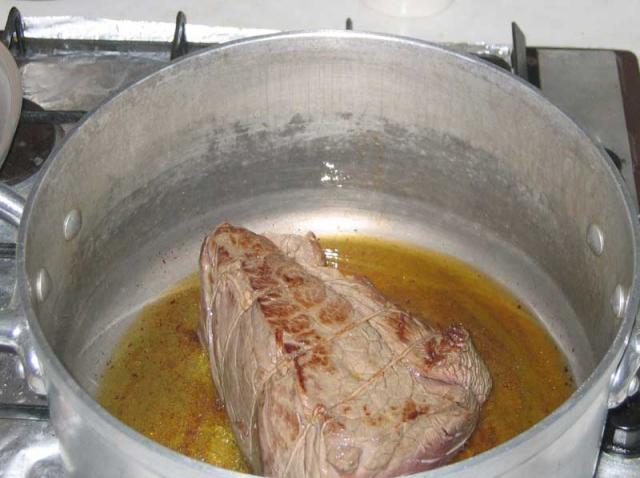
Searing the meat

sweating the onion, garlic and "secret"
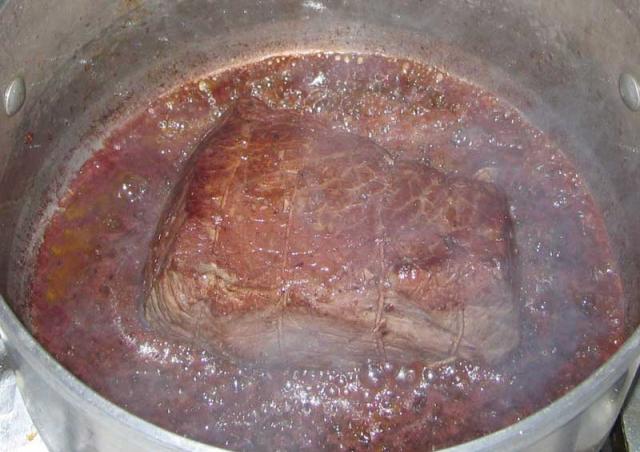
After the wine is reduced

The final result
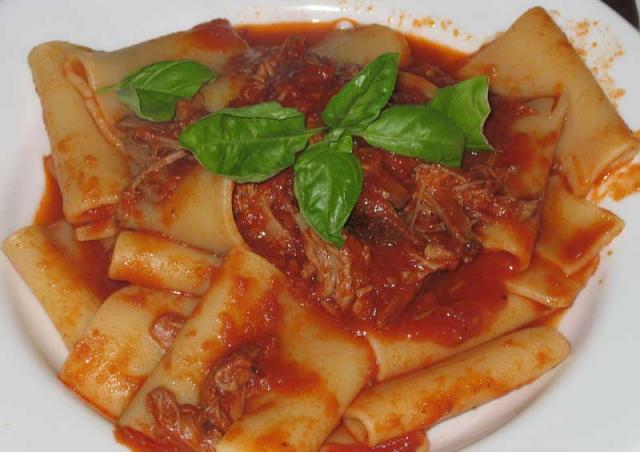 Paccheri al ragú: I have added some of the pasta cooking water to make the ragú less dense, as well as topping the pasta with some shreaded beef and Basil.
Paccheri al ragú: I have added some of the pasta cooking water to make the ragú less dense, as well as topping the pasta with some shreaded beef and Basil. -
Adam,
I do not know what a triple concentrate looks like. However, as we apparently live both in UK, I can talk about few brands which are ready available. Here in London, for example, is quite easy to find at any corner shop the concentrate by De Rica and Supercirio (both produced by Cirio group) which is more watery then the first and a Sainsbury double concentrate. I always use 400g of these (Cirio, De rica and Sainsbury) with no difference in the final result.
Ciao
-
Adam,
great pictures and process. I am not sure you've used enough tomatoes (at least 400g of double concentrate would have been necessary), and the wonderful sauce turned out to be more like (in colour and consistency) to the other famous Neapolitan sauce, Genovese.
Also, very true about the Maillard reaction point, however about your statement "I am thinking that the origins of the Neapolitan recipe may lie in a way of preserving meat also - this is just a guess though", I would like to give you a more strong base to its origin:
The Ragú was developed by the poor and average people, certainly not in the kitchen of the riches. To those people only cheap cut of meat were available, the one full of connective tissue (such as silverside or top rump). Those cuts, as you may well know, need a long slow cooking so that the "tendons" and fat can gelatinize and produce a soft, juicy meat that melt in the mouth. So more then preserving, this way of cooking was necessary to obtain a succulent piece of meat from a cheap cut.
Ciao
-
Adam,
The wine is only added before the tomato.
Once the conserva is in, you can add a cup at the time of hot water. We say that the ragú has to "pippare", it basically has to have constant little explosion on the surface like the magma (this is the best I can think of as a visual translation). To do so the consistency has to be quite dense, but not too much otherwise you may risk to burn it
Ciao
PS: Which tranlsation of Francesconi are you using? Schwartz or the one available on the net, I believe at ask.com?
-
We do not seam to understand each other, but I too have enjoyed discussing with you. It is funny that you are using Capatti & Montanari bibliography when I own editions of most books mentioned by them. Latini wrote indeed the first recipe of tomatoes but about 150 years earlier a botanist had alread written about the "strange custom of neapolitans of eating tomatoes"....
My insistance is that the recipe in 1839 is almost identical to the modern one with exclusion of lard (it contains the tomato conserve, onion, piece of beef and "pisto" spices-still used in my family recipe).
Again the word ragú was coined in Neapolitan and was borrowed to indicated similar sauces, but the only authentic one, I confirm, it is still the neapolitan version.
Kind regards
Marco
Just to clarify, I'm not American - not that there is anything wrong with that.
And nor are Alberto Capatti and Massimo Montanari as far as I know.
I'm curious that if you stress the importance of academic sources, why there is this insistance that Neapolitan Carne al Ragú is the origin of "Ragú" in print. As the oldest recipe that you have demonstrated for this dish is from 1837, which is very late and there are other earlier references that have that use the word, this is not logical.
Not that I think it that important, other then to point out that there are likely to be numerous dishes in Italy that can be called "Ragú", even if the origin of the word is likely to be an Italianization of the French word and this is likely to have occured in Naples. But, there is no evidence that I can see that the word was originally applied to the Modern dish at all. It would be great if this is so, but an 1837 reference is just far to late. Also, language is not set in stone and is determined by usage, I imagine that in the last 160 years a few more legitimate regional uses of the word "Ragú" may have evolved
I think that I might take that tact of Artusi and drop the all reference to "Ragú" and just name the Northern and Southern dishes after there cities of origin.
I must say that I have enjoyed this discussion as I have learn a great deal. I am really interested in how important Naples was in changing the food map of Italy. It does seem that many innovations (especially French and Spanish) were introduced into Italian cuisine via Naples. For instance the first centry of tomatoes is centred aroud this city. Latini's 1692 (alluded to above) recipe is the first Italian reference to a tomato recipe, it is called "Spanish Tomato Sauce" and is essentially the same as a modern salsa fresca.
-
Adam,
I agree that there is a mis-communication, but it is mostly to how people have adapted the word ragú to other sauce that were never called in this way in Italy.
Almost all the Italian reference that you have listed (il Cuoco Galante, La cucina Casareccia (also Neapolitan writer) just confirm what i was talking about: The word Ragú is of Neapolitan origin and represent One type of sauce.
I guess you have taken those reference from an American writer whilst I do own Copies of the above two text as well as another Vincenzo Corrado' book and even a 1600's book that has the first recipe with tomatoes (most writers refer to an early, about 1780, work of V. Corrado, as to the first written reference to eating tomatoes).
About Leonardi, it is well known in Italy that he draw from many Italian regions for his recipes, but mostly from Naples, where he took the Pasta with tomatoes as well as the Ragú you have mentioned.
Carne al Ragú is still how the Beef cooked in that way is called, whilst other cheap cut are only called Ragú.
Also about your interest, you may be aware that the Neapolitan dialect is in many respects a completely different language from Italian. This may be partialy due to the many Spanish and French influences, as well as the fact that up to 1860 Italy was divided in many small kingdoms.
The use of the word Ragú in neapolitan may have been inspired by the French Ragout, but was never meant to represent the same thing. There is another example about a french word used for "Sir", that in Naples was used first to represent any People that tried to be posh (from barbers to cooks) but at the end, transformed, became the exclusive title of cooks.
So to clarify this for you, the route that Ragout became Ragú in Neapolitan is not the same for which the "Bolognese" (as it is simply known in Italy) have become Ragú Bolognese abroad (I would reserch it between the first bolognese emigrants that adapted the word Ragú of the Neapolitan sauce to theirs so to make it easier to explain to foreign people. It has nothing to do with the fact that a french ragout may have been translated in Bologna.
It is also known that Francois Pierre de La Varenne actually included (with some modifications) many Italian recipes in his book (so to talk about cross-influences). His book Italian translation is also famous as to have introduce the word "Besciamella" (Bechamel) in Italian.
Ciao
I think that there is a mis-communication in this post somewhere. So to clarify I will post some interesting things I have learnt recently (which is the useful thing about posts like this as it forces one to look up information and data).I have not doubt that there is proud tradition of Ragú making in Naples, this is not an issue. However, my earlier response to the origins of "Ragú", was in response to these comments.
The Ragú is only neapolitan... the other sauce should only be called Bolognese.The first record of ragú is on neapolitans cookbooks of the 19th century.
I believe that this refers to the work of Duke Ippolito Cavalcanti "La cucina teorico-practica" (published in 1837, so not that early in the 19th century), who rendered French phonetically into Italian and in later works (post-1846) used Neapolitan dilect as well. This work does indeed contain what looks like an archetypal recipe for Neapolitan Ragú. I haven't got a copy of this work, but from what I can work out this recipe is called "Carne al Ragú". As Neapolitans obviously have a very good idea of what "Ragú" should be, it would seem that there may have been a contraction to simply "Ragú".
But there are earlier uses of the word "Ragú" in print. La cucina casereccia printed 25 times between 1807-1885 was nurmerous Italianized French cooking terms, including "Gatto" (gateau) and "Ragú" (ragout).
But before this there are earlier examples. In Francesco Leonardi's "Apicio Moderno (1790) a "Ragú di Animelle" as a componant recipe of "Gatto di Lasagne alla Misgrasse".
In both of these cases there are very strong Neapolitan connections.
My original interest was trying to determine when the Italianization of the French term occured and what types of recipes this was associated with. I haven't quite managed to do this, but I did find out some an interesting bit of information that might be of interest to people with access to historical Italian language cookbooks.
Most people interested in food history know of Francois Pierre de La Varenne's "Le Cuisinier Francois", first printed in 1651 - it is one of the most, if not the most influencial, cookbooks produced in Europe. What is interesting is that it's impact in Italy was also great. Translated into Italian as "Il cuoco francese", there were at least 13 re-printings published between 1682 and 1826! An incredible record. I have facsmile of the 17th century English language version, there are many many recipes for ragout (spelt "ragoust"). In the case of the Italian labguage versions, it should be possible to pin- point the period in which ragout became ""Ragú". Also, as the first Italian language printing came out of Bologna, if the modern form of the word was in this addition it would give much evidence to suggest that the Northern-Italian version was older then the Neapolitan. Sadly, I don't have access to these books.

-
Adam,
The same things as Ragú (but without tomatoes) was cooked in Naples for a very long time and it was called simply "Stufato". The earliest version of the Ragú I am talking about (let's call it Napoletano), was written around 1830 (from being cooked by the neapolitan population to the time it finally appeared on a cookbook you surely agree that it may have past some times...) and was almost identical to the modern one (probably with the exclusion of the randered pork fat that people do not use for healt concern).
The word ragout and a version similar to the French one was surely available at the table of nobility in the neapolitan kingdom, where French cusine was a posh thing...
My point being that the earliest document of the SAME RAGÚ, including being a tomato sauce, was written in the eraly part of '800.
You would also surely know that the way French words are adapted in English follows a different route that the ones adapted in Italian (refer to the many rexplenations in the Oxford dictionary), with Italian having the strongest link to Latin.
Ciao
(please refer to cookbook written in Italian that mention so many Ragú as well as written on this forum because I still believe that this is an invention of English writers)
Ragout has many forms, not just lamb, as ultimately it was more of a garnish then anything. That is the meaning of the orginal french term really. In the more degenerate forms you see in English cookbooks this idea tends to be lost.One mid-18th century English cookbook has a recipe for "Tete de Veau au ragout melee" (Calve's head with mixed ragout). In this case the ragout consists of sweetbreads, bacon, eggs, poultry liver, testicles, sauce, parsley and lemon juice.
The point being that if the earliest reference to "Ragú" is 19th century, then it is very late. I find it hard to believe that the Italians are 200 years behind the English in terms of a cooking term.
Maybe the exact spelling of "Ragú" did not appear until this late date (I doubt it though), but there should be earlier variations. In English there are numerous variations on how this term is spelt, until it settled on "ragout".
Regarding "Ragú" in Sicily, I have a recipe here for "Ragú Siciliano delle Feste". May or may not be real, depending on the Italian you ask.

-
I was infact specifically referring to the word ragú and not rogout from which it share the same root (as many other word in Neapolitan as well as I am sure you can find many reference on the greek, Spanish and french influence on neapolitan cooking).
However the Ragú is completely different from a ragout:
1-Ragout is made with monton/lamb
2 Ragout It doesn't involve a tomato sauce
3- Ragout consist of the addition of many vegetable
etc...
Not all meat sauce are called Ragú in Italy(infact only the neapolitan one), this seams a corruption that has happened in the English translation.
-
I am also a neapolitan and I have something to say about the RAGÚ...
The Ragú is only neapolitan... the other sauce should only be called Bolognese.
The first record of ragú is on neapolitans cookbooks of the 19th century.
I have to correct Alberto about the meat cut, but this may be due to the fact that each "mamma" has her own version of the king of the sauce in Naples. Even though most neapolitans prefer pork meat cuts like "tracchiolelle (spare ribs)" o "Gallinella (the knukle)", originally the ragú was made with top rump or silverside of beef. The best modern versions call even for a mixture of Beef and Pork, including the cuts above as well as sausages.. My Grandmother does it with a mixture of Pork and Beef including "cotica" (pork underskin), which she prepares as stuffed rolls...
I do agree with Alberto on the other things he said as well as Ziti (and I had Fusilli) being the best pasta, Red wine (aglianico) and the COnserva...
Also the lamb is not used for Ragu in Naples and even as meat in general. Most commonly actually we prefer Goat (actually Kid), which we do consume on Easter (my family also consume free range kids on Christmas lunch)



All About Pizza
in Italy: Dining
Posted · Edited by Pizza Napoletana (log)
They are finally open and have also a website
Pizzeria Salvo